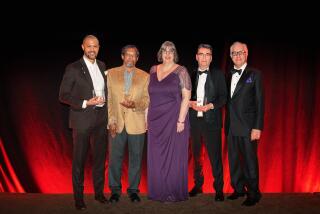High-Concept How-to Books
- Share via
If every other person in Los Angeles seems to be writing a screenplay, the rest seem to be publishing screenwriting guides. “Those who can’t do, teach” would be overstating things, but on the other hand, these authors aren’t exactly auteurs, either. In honor of the updated second edition of “The Complete Idiot’s Guide to Screenwriting,” we ran a few credits, courtesy of movie database www.imdb.com.
*
“The Complete Idiot’s Guide to Screenwriting”; (Alpha Books, July 2004)
Author: Skip Press, author, screenwriter, online writing instructor, former editor of Entertainment Monthly.
Credits: The 1987 instructional video “A Woman’s Guide to Firearms.”
*
“Story: Substance, Structure, Style and the Principles of Screenwriting” (ReganBooks, 1997)
Author: Robert McKee, a screenwriting instructor profiled in Vanity Fair magazine. His website, www.mckeestory.com, boasts that graduates of his course have been nominated for 94 Academy Awards and have won 24.
Credits: Writer on the 1994 TV movie “Abraham” as well as an episode of the TV series “Kate Loves a Mystery” in 1979. Portrayed by Brian Cox in the 2002 film “Adaptation.” Appeared as himself in the comic documentary “20 Dates” in 1998.
*
“Screenplay: The Foundations of Screenwriting” (MJF Books, 1998)
Author: Syd Field, celebrated writing-seminar guru and writer of numerous screenplay how-to books, has been dubbed “the most sought-after screenwriting teacher in the world” by the Hollywood Reporter.
Credits: “Story concept” credit on the short film “Mnemosyne” (2002). Acting credit in the feature “When a Man Loves a Woman.” Appeared as himself in the “mockumentary” “R2PC: Road to Park City.” American Screenwriters Assn. Screenwriting Hall of Fame selection, 2001.
*
“Writing Screenplays that Sell” (HarperPerennial, 1991)
Author: Michael Hauge. According to his website, www.screenplaymastery.com, Hauge is a “script consultant, screenwriter, author, lecturer and motivational speaker who works with writers, filmmakers and executives on their screenplays, film projects and development skills.”
Credits: Listed on www.imdb.com as “story writer” for “Heart of the Atom,” a feature “in production.”
*
“Write Screenplays That Sell: The Ackerman Way” (Tallfellow Press, 2003)
Author: Hal Ackerman, faculty member of the UCLA screenwriting program
Credits: “Special thanks” in the credits of the 2003 independent feature “Henry X”; “thanks” in the credits of the 1999 Miramax feature “A Walk on the Moon”; co-wrote the independent 1976 film “Second Wind.”
*
“Writing from the Inside Out: Transforming Your Psychological Blocks to Release the Writer Within” (Wiley, 2000)
Author: Dennis Palumbo. Listed at www.dennispalumbo.com as a licensed psychotherapist specializing in creative issues for artists and screenwriters.
Credits: Screenplay and story for MGM’s “My Favorite Year” (1982), which snagged a Writers Guild of America award nomination.
*
“The Screenwriter’s Bible: A Complete Guide to Writing, Formatting, and Selling Your Script” (Silman-James Press, 1998)
Author: David Trottier
Credits: Co-writer on “The Penny Promise” (2001), an independent feature; writer on the direct-to-video “Hercules Recycled” (1994).
*
“Secrets of Screenplay Structure: How to Recognize and Emulate the Structural Frameworks of Great Films” (Lone Eagle Publishing, 1999)
Author: Linda J. Cowgill, screenwriting instructor at Loyola Marymount University and the Los Angeles Film School.
Credits: Writer credit as “Gil Cowan” on “Opposing Force,” Orion, 1986.
More to Read
Sign up for our Book Club newsletter
Get the latest news, events and more from the Los Angeles Times Book Club, and help us get L.A. reading and talking.
You may occasionally receive promotional content from the Los Angeles Times.







